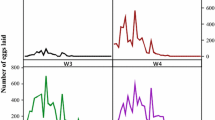Abstract.
In this study, engorged Amblyomma lepidum ticks were found to drop off in two peaks, one in the morning and one in the evening. Most larvae and females engorged during the morning hours between 06.00 h and 10.00 h with a peak around 08.00 h, whereas the majority of the nymphs dropped in the evening between 18.00 h and 24.00 h with the peak around 22.00 h. Although the effect of time on drop-off patterns of the ticks was statistically significant (p≤ 0.001), there were no significant seasonal influences. Survival of unfed stages of A. lepidum was also studied and was found to increase from larvae to adult ticks. The longest survival periods of 10, 11 and 14 weeks were recorded during the wet season for larvae, nymphs and adults, respectively. It is concluded that environmental conditions required for survival of A. lepidum are optimal only during the wet season and that during other seasons the tick depends primarily on prevailing micro-climatic conditions for its survival.
Similar content being viewed by others
References
K.P. Bailey (1960) ArticleTitleNotes on the rearing of Rhipicephalus appendiculatustheir infection with Theileria parva for experimental transmission Bull. Epiz. Dis. Afric. 8 33–43
Y.S. Balashov (1972) ArticleTitleBlood sucking ticks (Ixodoidea) vectors of diseases for man and animals Misc. Publ. Ent. Soc. Am. 8 161–376
D.C. Dark (1995) ArticleTitleLower temperature limits for activity of several Ixodid ticks (Acari:Ixodidae). Effect of body size and rate of temperature change J. Med. Entomol. 32 IssueID4 449–452 Occurrence Handle7650705
J. Du Toit L.J. Fourie I.G. Horak (1994) ArticleTitleDetachment rhythms of immature Ixodes rubicundus from their natural hostthe rock elephant shrew (Elephantus myurus). Onderstepoort J. Vet. Res. 61 149–153
A.A. Guglielmone (1992) ArticleTitleThe effect of temperature and humidity on longevity of Amblyomma triguttattum triguttattum (Acarina: Ixodidae) Bull. Ent. Res. 82 203–208
H.J. Harlan W.A. Fooster (1990) ArticleTitleMicro- meteorological factors affecting field host seeking activity of adult Dermacentor variabilis (Acari: Ixodidae) J. Med. Entomol. 27 471–479 Occurrence Handle2388223
S.M. Hassan (1997) Ecological studies on Rhipicephalus appendiculatus Amblyomma variegatum (Acari: Ixodidae). Drop off rhythmDevelopmentSurvival and Seasonal population dynamics University of Kenyatta Kenya 206
G. Karrar M.N. Kaiser H. Hoogstraal (1963) ArticleTitleEcology and host relationships of ticks infesting domestic animals in Kassala ProvinceSudan, with special reference to Amblyomma lepidum Buul. Ent. Res. 54 509–522
S. Kitaoka (1962) ArticleTitlePhysiological and ecological studies on some ticks VIII. Diurnal and nocturnal changes in feeding activity during the blood sucking process of Haemaphysalis bispinosa Natl Inst. Anim. Hlth Quart. 2 IssueID2 106–111
J.I. Minshull (1982) ArticleTitleDrop off rhythms of engorged Rhipicephalus appendiculatus (Acari: Ixodidae) J. Parasitol. 68 484–489 Occurrence Handle7097445
E.N. Mwangi R.M. Newson G.P. Kaaya (1991) ArticleTitleDrop off patterns of engorged adult females, nymphs and larvae of Rhipicephalus appendiculatus Insect Sci. Appl. 12 IssueID5/6 629–633
R.A. Norval (1977) ArticleTitleStudies on the ecology of the tick Amblyomma hebraeum (Koch) in the Eastern Cape Province of South Africa II. Survival and development J. Parasitol. 63 IssueID4 740–747 Occurrence Handle577931
A.M. Osman (1976) ArticleTitleA review on tick-borne diseases in the Sudan Their control. Bull. Int. Epiz. 86 81–88
A.M. Osman (1978) Water relation of Sudanese ticks of the genus Amblyomma J.K.H. Wilde (Eds) Tick-borne diseases and their vectors CTVM U.K
R.G. Pegram D.S. Banda (1990) ArticleTitleEcology and phenology of cattle ticks in Zambia. Development and survival of the free-living stages Exp. Appl. Acarol. 8 291–301 Occurrence Handle2350995
D.K. Punyua (1992) ArticleTitleA review of the development and survival of ticks in tropical Africa Insect Sci. Applic. 13 IssueID4 537–544
Y. Rechav (1978) ArticleTitleDrop off rhythms of engorged larvae and nymphs of the bont tick Amblyomma hebraeum (Acari: Ixodidae) and the factors that regulate them J. Med. Entomol. 14 IssueID6 677–687
K.C. Stafford (1994) ArticleTitleSurvival of immature Ixodes scapularis (Acari:Ixodidae) at different relative humidities J. Med. Entomol. 31 IssueID2 310–314 Occurrence Handle8189424
R.W. Sutherst M.J. Dalwitz R.B.W. Utech J.D. Kerr (1978) ArticleTitleAspects of host finding by the cattle tick Boophilus microplus Aust. J. Zool. 26 159–174 Occurrence Handle10.1071/ZO9780159
E.M. Tukahirwa (1976) ArticleTitleThe effect of temperature and relative humidity on the development of Rhipicephalus appendiculatusNeuman. (Acari: Ixodidae) Bull. Entomol. Res. 66 301–312
I. Yeruham A. Hadani F. Galker S. Ronsen A. Gundens (1995) ArticleTitleThe daily distribution and circadian rhythms of detachment of engorged Rhipicephalus bursa tick from lambs and rabbits Med. Vet. Entomol. 9 445–447 Occurrence Handle8541602
Author information
Authors and Affiliations
Corresponding author
Rights and permissions
About this article
Cite this article
Mohammed, A., Elmalik Khitma, H. & Hassan, S. Drop off rhythm and survival periods of Amblyomma lepidum (Acari: Ixodidae) under field conditions. Exp Appl Acarol 36, 225–232 (2005). https://doi.org/10.1007/s10493-005-5070-5
Received:
Accepted:
Issue Date:
DOI: https://doi.org/10.1007/s10493-005-5070-5




